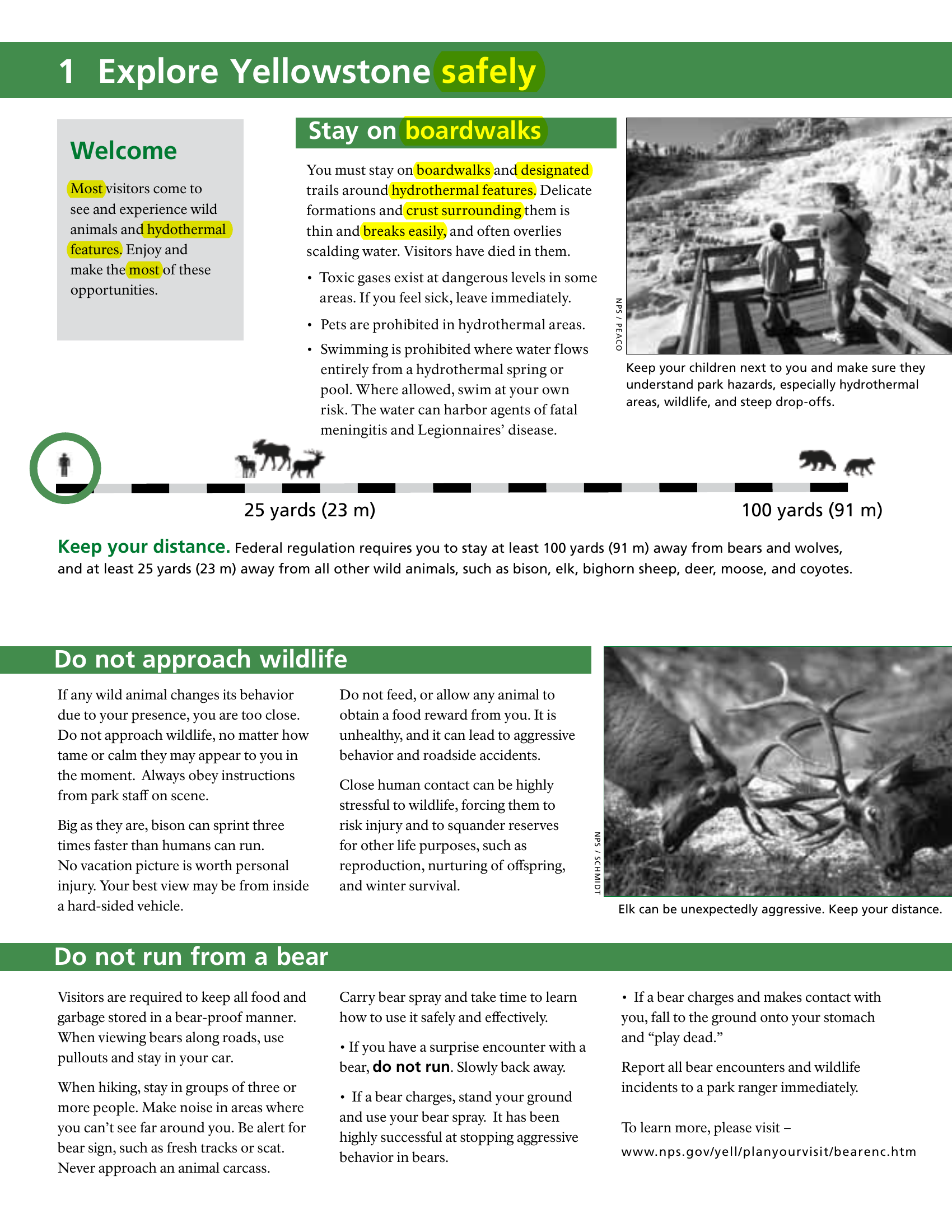Yellowstone National Park Trip Planner
Publié le 15/04/2013
Extrait du document
«
1 Explore Yellowstone safely
You must stay on boardwalks and designated
trails around hydrothermal features.
Delicate
formations and crust surrounding them is
thin and breaks easily, and often overlies
scalding water.
Visitors have died in them.
• To x i c gases exist at dangerous levels in some
areas.
If you feel sick, leave immediately.
• Pets are prohibited in hydrothermal areas.
• Swimming is prohibited where water f lows
entirely from a hydrothermal spring or
pool.
Where allowed, swim at your own
risk.
The water can harbor agents of fatal
meningitis and Legionnaires’ disease.
Stay on boardwalks
Keep your children next to you and make sure they
understand park hazards, especially hydrothermal
areas, wildlife, and steep drop-offs.
n npS / peaCo
Welcome
Most visitors come to
see and experience wild
animals and hydothermal
features.
Enjoy and
make the most of these
opportunities.
Keep your distance. Federal regulation requires you to stay at least 100 yards (91 m) awa\ y from bears and wolves,
and at least 25 yards (23 m) away from all other wild animals, such as\ bison, elk, bighorn sheep, deer, moose, and coyotes.
25 yards (23 m) 100 yards (91 m)
Do not approach wildlife
npS / SChmidt
If any wild animal changes its behavior
due to your presence, you are too close.
Do not approach wildlife, no matter how
tame or calm they may appear to you in
the moment.
Always obey instructions
from park staff on scene.
Big as they are, bison can sprint three
times faster than humans can run.
No vacation picture is worth personal
injury.
Your best view may be from inside
a hard-sided vehicle.Do not feed, or allow any animal to
obtain a food reward from you.
It is
unhealthy, and it can lead to aggressive
behavior and roadside accidents.
Close human contact can be highly
stressful to wildlife, forcing them to
risk injury and to squander reserves
for other life purposes, such as
reproduction, nurturing of offspring,
and winter survival.
Visitors are required to keep all food and
garbage stored in a bear-proof manner.
When viewing bears along roads, use
pullouts and stay in your car.
When hiking, stay in groups of three or
more people.
Make noise in areas where
you can’t see far around you.
Be alert for
bear sign, such as fresh tracks or scat.
Never approach an animal carcass.
Do not run from a bear
Carry bear spray and take time to learn
how to use it safely and effectively.
• If you have a surprise encounter with a
bear,
do not run .
Slowly back away.
• If a bear charges, stand your ground
and use your bear spray.
It has been
highly successful at stopping aggressive
behavior in bears.
• If a bear charges and makes contact with
you, fall to the ground onto your stomach
and “play dead.”
Report all bear encounters and wildlife
incidents to a park ranger immediately.
To learn more, please visit −
www.nps.gov/yell/planyourvisit/bearenc.htm
elk can be unexpectedly aggressive.
Keep your distance..
»
↓↓↓ APERÇU DU DOCUMENT ↓↓↓
Liens utiles
- Yellowstone National Park - geography.
- Yellowstone National Park.
- Yellowstone National Park - geography.
- L'énergie du coeur de la Terre Source chaude du Grand Prismatic dans le parc national de Yellowstone, États-Unis.
- Yellowstone (« Pierre jaune », en anglais), grand parc national des États-Unis, créé en 1872 sur 8 500 km 2, situé dans l'État du Wyoming.

































